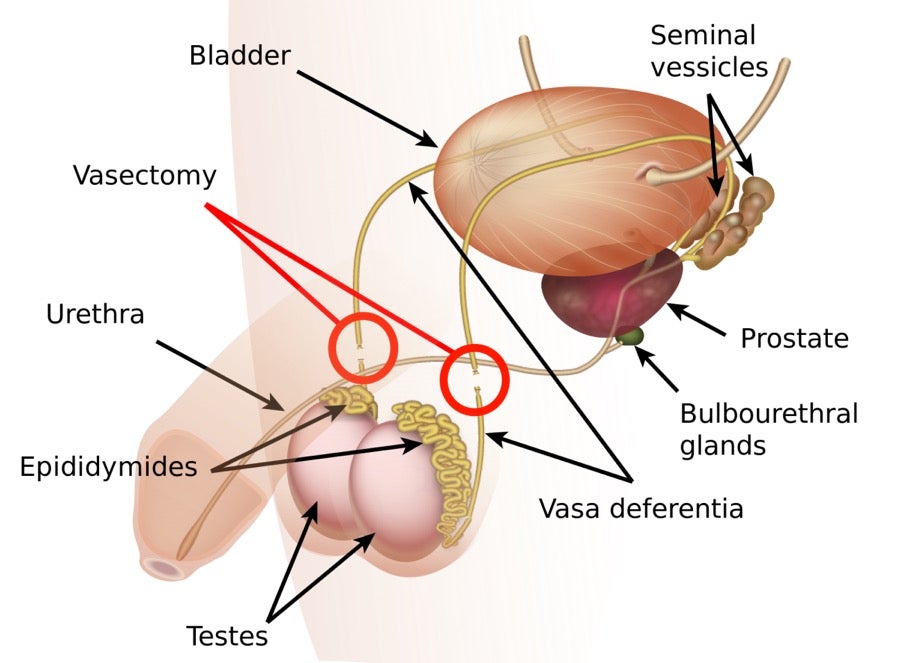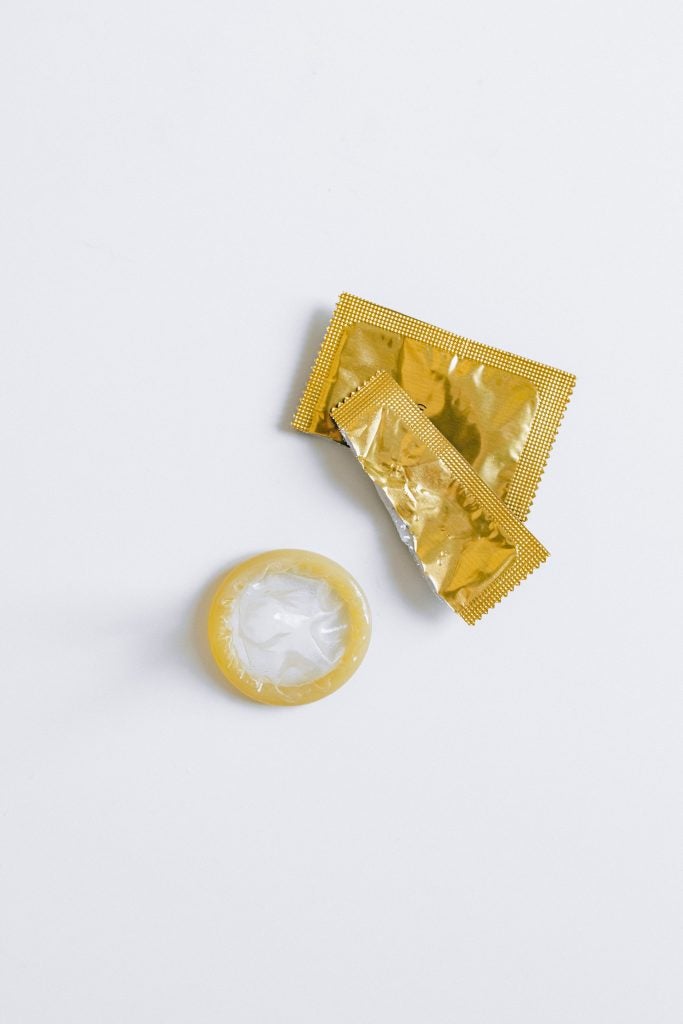Table of Contents
Male Sterilization

A vasectomy is a permanent method of birth control for males. It is a surgical procedure, typically involving local anesthesia, in which the vas deferens are cut, tied, or blocked off so that sperm cannot leave the scrotum. This procedure prevents the expulsion of sperm from the male’s body during ejaculation, thus eliminating the chance of pregnancy.A local anesthesia is injected into the scrotal area so that the patient will not experience any pain. The vas deferens is located by touch and a small incision is made in the scrotum to expose it. The doctor then cuts and removes a small section of the vas deferens and sews together or cauterizes the ends. The incision is sutured shut and the entire procedure is repeated for the other vas deferens. The procedure is very simple and generally takes around 30 minutes. The patient should avoid any type of strenuous physical activity for several days, apply ice to the site of incisions, and take mild painkillers for pain management if necessary.
Vasectomies do not result in immediate steriliziation because sperm still remains in the upper portion of the vas deferens. However, all of the sperm is usually flushed out within 12-15 ejaculations, or after around 10 weeks.1 During this time, males are advised to use an alternate method of birth control and undergo semen analysis once every couple weeks to check for semen. The male is considered sterile once he has received two negative semen analysis tests.
Things to Consider

Male sterilization is generally an irreversible form of birth control. As with any permanent change to the body, anyone considering a vasectomy should consider the impact the procedure will have on their life. Oftentimes, if a male is in a committed relationship and is considering a vasectomy, they will fully include their partner in their decision-making process before the procedure. Before finalizing the choice, males and their partner(s) should consider whether or not there any circumstances in which they would want to have (more) children in the future. If there is any chance of a desire to have a child in the future, some males freeze a sperm sample before their vasectomy. This method gives a male the option to impregnate their partner if they later decide to have (more) children. If sterilization seems too permanent or invasive, one should instead consider alternative forms of birth control.
A vasectomy is a permanent and irreversible procedure. Though it is technically possible to reverse a vasectomy, the reversal surgery is very expensive and may not be effective. Post-vasectomized males opting for a reversal procedure in order to have children can face decreased fertility post-procedure. One study found that previously vasectomized males had lower sperm counts than males who had not undergone the procedure. Furthermore, males who had their vasectomies reversed in order to conceive children also had lower pregnancy success rates than males who had never had a vasectomy.3 In conclusion, because vasectomy-reversal surgery is not always effective and a vasectomy can decrease fertility in males, it is paramountly important that males considering a vasectomy be confident in their decision to be sterilized.
Potential Problems
Although a vasectomy is an extremely safe procedure, complications may arise. Complications include mild infections, bruising, abscesses such as blisters, sores, and inflammation, swelling containing fluid or blood, and arousal or erectile problems.4 Most of these complications can be taken care of fairly easily with antibiotics, bed rest, heat or ice application, or surgical drainage. If one experiences any of these symptoms, they should contact their doctor immediately.
It is also important to note that the vas deferens may recanalize, or grow back together, soon after the surgery.5 The risk of this natural reversal is much higher during the first few months after the surgery, so it is vital to continue regular semen analysis for several months after the procedure.
Sex After a Vasectomy
A vasectomy does not alter sexual pleasure or sensation. Sex should be just as enjoyable as before. Many males may falsely believe that they will no longer be able to ejaculate following a vasectomy. However, this procedure only interferes with the ability for sperm to enter the ejaculate. Sperm only makes up approximately 1% of the total volume of ejaculate. The rest of the ejaculate is produced in other glands such as the seminal vesicles and the prostate gland. Therefore, having a vasectomy will have a minimal effect on the volume of the ejaculate.2
Advantages

There are many advantages to choosing male sterilization. Some reasons males and their partners opt for vasectomy are as follows:
- It is a permanent method of contraceptive.
- There are no reoccurring actions, such as a female taking birth control daily, needed by the user.
- Male sterilization is easier and cheaper than female sterilization.
- It is very effective.
- It has a fast recovery.
- It allows spontaneity (in the sense that you do not need to stop and put a condom on when it is getting hot and heavy!)6
Whatever the reason to make the decision to have a vasectomy, males and their partners should fully consider both the advantages and disadvantages of the procedure.
Disadvantages
There are a few drawbacks to having a vasectomy that should be considered before making the decision to have the procedure. Some things to consider are:
- Vasectomies do not protect against sexually transmitted infections.
- There are possible surgical complications.
- The resulting sterilization is permanent — some males may regret their decision.
Once one has considered all the advantages and disadvantages to having a vasectomy, an informed decision can be made.
Effectiveness
The vasectomy has a failure rate of only 0.1%, making it the second most effective form of birth control (behind abstinence).5
Cost
The cost of having a vasectomy can vary anywhere from $250 to $1000. This price includes the cost of the consultation, the actual procedure, and any follow up visits.6
Concluding Remarks

Male sterilization can be an effective option of permanent birth control for many males and their partners. There are many advantages to choosing a vasectomy, including its relatively low cost, effectiveness, permanence, and fast recovery. Disadvantages of male sterilization to be considered include the possibility of surgical complications, the inability of vasectomies to protect against STIs, and its permanence. The permanence of this procedure and the reduced fertility are two reasons that males should carefully consider the vasectomy before getting the procedure. For those who are absolutely certain that they have no desire to have (more) children, male sterilization can be a great option.
References
1. “Vasectomy”. Johns Hopkins Medicine, 16 Apr. 2017.
2. Greenberg, Jerrold S., Clint E. Bruess, and Sarah C. Conklin. “Male Sterilization.” Exploring the Dimensions of Human Sexuality. 4th ed. Sudbury, MA: Jones and Bartlett, 2011. 203-204. Print.
3. C.M. McVicar, D.A. O’Neill, N. McClure, B. Clements, S. McCullough, S.E.M. Lewis. “Effects of vasectomy on spermatogenesis and fertility outcome after testicular sperm extraction combined with ICSI”. Hum Reprod 2005; 20 (10): 2795-2800.
4. LeVay, Simon, Janice Baldwin, and John Baldwin. “Chapter 9: Contraception and Abortion”. Discovering Human Sexuality. Sunderland: Sinaur Associates, Inc., 2009.
5. Peterson HB, Xia Z, Hughes JM, et al. The risk of pregnancy after tubal sterilization: findings from the US Collaborative Review of Sterilization. Am J Obstet Gynecol. 1996;174(4):1161-1168; discussion 1168-1170.
6. “Vasectomy”. Planned Parenthood, 16 Apr. 2017.
Last Updated: 16 April 2017.
